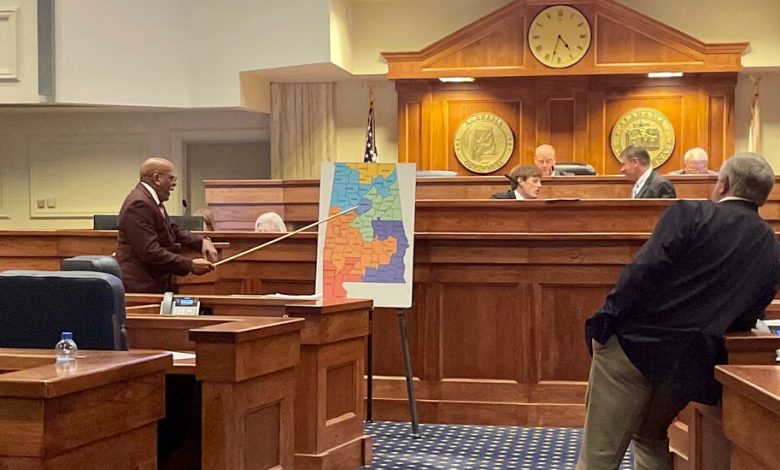Federal Court Again Strikes Down Alabama’s Congressional Map

A panel of federal judges rejected Alabama’s latest congressional map on Tuesday, ruling that a new map needed to be drawn because Republican lawmakers had failed to comply with orders to create a second majority-Black district or something “close to it.”
In a sharp rebuke, the judges ordered that the new map be independently drawn, taking the responsibility away from the Republican-controlled legislature while chastising state officials who“ultimately did not even nurture the ambition to provide the required remedy.”
The legislature had hastily pushed through a revised map in July after a surprise Supreme Court ruling found that Alabama’s existing map violated a landmark civil rights law by undercutting the power of the state’s Black voters. The revised map, approved over the objections of Democrats, increased the percentage of Black voters in one of the state’s six majority-white congressional districts to about 40 percent, from about 30 percent.
In its new ruling, the district court panel in Alabama found that the legislature had flouted its mandate.
“We are not aware of any other case in which a state legislature — faced with a federal court order declaring that its electoral plan unlawfully dilutes minority votes and requiring a plan that provides an additional opportunity district — responded with a plan that the state concedes does not provide that district,” the judges wrote.
Responsibility for a new map now falls to a special master, Richard Allen, a longtime Alabama lawyer who has worked under several Republican attorneys general, and a cartographer, David Ely, a demographer based in California. Both were appointed by the court.
The decision — or the independent map to be produced— can be appealed. State officials have said that a new congressional map needs to be in place by early October, in order to prepare for the 2024 elections.
The litigation has been closely watched in Washington and across the country, as several other states in the South face similar voting rights challenges, and control of the U.S. House of Representatives rests on a thin margin. Prominent lawmakers in Washington — including Speaker Kevin McCarthy of California and Democrats in the Congressional Black Caucus — have kept careful tabs on the redistricting effort.
At least one nonpartisan political analysis has predicted that at least one Alabama district could become an election tossup with a new map, given that Black voters in Alabama tend to vote for Democratic candidates.
The decision was joined by Judge Stanley Marcus, who was nominated by former President Bill Clinton; and by Judges Anna M. Manasco and Terry F. Moorer, both named to their posts by former President Donald J. Trump. (Judge Marcus typically sits on the U.S. Court of Appeals for the 11th Circuit, in Atlanta.)
For Alabama, the ruling caps off nearly two years of litigation, marking yet another instance in the state’s tumultuous history where a court has forced officials to follow federal civil rights and voting laws.
Two decades ago, a lawsuit forced the creation of the Seventh Congressional District, the state’s sole majority-Black district, in southwest Alabama. (Under the Republican-drawn map rejected on Tuesday, the share of Black voters in that district dropped to about 51 percent from about 55 percent.)
“It’s really making sure that people who have consistently been kept at the margins or excluded as a matter of law from politics have a chance — not a guarantee — but a realistic chance of electing candidates of choice,” said Kareem Crayton, the senior director for voting and representation at the Brennan Center for Justice and a Montgomery, Ala., native. “The fact that we’re having to fight over that principle is really sad in 2023.”
After the 2020 census, which began the process of setting district lines for the next decade across the country, the Alabama legislature maintained six congressional districts with a white Republican incumbent. A group of Black voters challenged the map under a landmark voting rights law, given that more than one in four residents of Alabama is Black.
The Birmingham court said the map would need to be redrawn, but the Supreme Court intervened and said a new map could not be put in place so close to the primary races ahead of the 2022 election.
In doing so, the Supreme Court unexpectedly affirmed the key remaining tenet of the Voting Rights Act of 1965, which bars any voting law that “results in a denial or abridgment of the right of any citizen of the United States to vote on account of race.” The court had gutted much of that landmark civil rights law a decade earlier, and many had expected a similar result with the Alabama case.
But in a weeklong special session, Republicans refused to create a second majority-Black district, and shielded their six incumbents from a potentially brutal primary at a moment when the party has only a slim majority in the U.S. House of Representatives.
Republicans defended their revised map, calling it a fair attempt to keep counties and communities with similar economic and geographic issues together, while adhering to the Constitution. Democrats and the Black voters who brought the challenge called it a squandered opportunity to provide equal representation to a historically disenfranchised bloc of voters.
At a hearing in August, the panel of judges sharply pressed the state’s attorneys on whether the revised map had done enough to adhere to their guidance on how to address the voting rights violation, making their skepticism clear.
“What I hear you saying is that the state of Alabama deliberately disregarded our instructions,” Judge Moorer said at one point.





